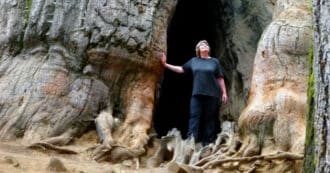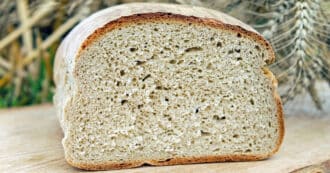In Genesis 25 we read about how Abraham marries a new wife named Keturah and the long list of children that come from their marriage:
She bore him Zimran, Jokshan, Medan, Midian, Ishbak, and Shuah. And Jokshan begat Sheba, and Dedan. And the sons of Dedan were Asshurim, and Letushim, and Leummim. And the sons of Midian were Ephah, Epher, Hanoch, Abidah, and Eldaah. All these were the children of Keturah.
A Summary of Genesis 25
In the end, Abraham “gives everything he has to Isaac,” but also gives these other children “gifts” before sending them away. Then Abraham “breathed his last,” “was gathered to his people” and is buried by his sons Isaac and Ishmael in the cave of Machpelah.
After the death of Abraham, we read of how God blessed his son Isaac, and how Isaac dwelt by Beer Lahai Roi. We hear about the sons of Ishmael, how Ishmael dies and then the story continues with Isaac.
Similar to Abraham and Sarah, their child, Isaac, and his wife, Rebekah, are unable to have a child. But when Isaac prays, his prayers are answered and she becomes pregnant with twins. The twins struggle within her and she begins to question her life. God informs her that there are “two nations” in her womb and how “the elder shall serve the younger.”
The first appears red and hairy, and he is named Esau. The other is born holding onto Esau’s heel and so he is named Jacob, which means heel. They grow up and Esau becomes a hunter while Jacob becomes a simple tent dweller. Isaac loves Esau because Esau brings him tasty meat that he hunts, but Rebekah prefers Jacob.
The chapter ends with a story of Esau coming home famished from a hunt and begging Jacob to feed him some of the lentils Jacob had made. Jacob agrees, but on condition that Esau sells his birthright in exchange for those lentils. Esau agrees to these conditions, gulps down the lentils and leaves.
Eco Bible on Genesis 25
Needs Versus Luxuries, from Genesis 25
Genesis 25:23 – and the Lord Answered Her, “Two Nations Are in Your Womb, Two Separate Peoples Shall Issue from Your Body; One People Shall Be Mightier Than the Other, and the Older Shall Serve the Younger.”
Rashi comments: “These [two nations] are Antoninus and Rabbi, for neither radish nor lettuce ceased [to be found] on their tables neither during the sunny season nor during the rainy season.”1 The Talmud states: “They [Antoninus and Rabbi] were ‘proud ones’ in that they were so wealthy that they could afford to have seasonal products all year round.”2 Antoninus was the Roman emperor, and Rabbi (Judah the Prince) was a key Jewish leader in Roman Judaea.
This Talmudic teaching reveals how food availability has changed dramatically in the transition from pre-modern, pre-industrial society to modern industrial society. Today most Westerners take for granted the availability of seasonal produce all year. Ironically, Israel exports significant amounts of “summer produce” grown in greenhouses in the winter to Europe, including Rome. This does not just include radish and lettuce but an array of tropical fruits, including mango, which was unheard of in the time of Rabbi and Antoninus. While the amounts of vegetables exported have declined somewhat in the last decade, exports of avocados and dates have increased.3
This can help us gain perspective on how we define need versus luxury. What were considered luxuries for our parents and grandparents are now essential items to our generation. Yet choosing to live with fewer material products and favoring local produce is a critical part of sustainable living. It becomes much easier when religious communities encourage and exemplify sustainability. In this regard, the emergence of “green teams” at houses of worship is an encouraging development. These green places of worship champion sustainability, often by using solar power, composting, and maximizing the use of locally grown fruit and vegetables in their events.
The Conflict of Jacob and Esau: Sustainability or Destruction, by Rabbi Shaul David Judelman
Genesis 25:27 – When the Boys Grew Up, Esau Became a Skillful Hunter, a Man of the Outdoors; but Jacob Was a Mild Man Who Stayed in Camp.
The verse describes the growth of the two children. We can interpret this as saying Esau lives his life in the field, a place of open uncertainty, while Jacob is of the tent and the home, a place of stability and conviction. Esau and Jacob are destined for conflict, as prophetically related to Rebecca when she inquired of the unrest she felt in her womb. The dichotomy here is between the driving force of Esau’s unbridled desire and Jacob’s Tikkun, or repair, of this urge. Resulting tension pervades their interactions.
Kabbalistic interpretations teach that Esau’s soul came from the world of Tohu (chaotic and wild).5 This phrase refers to the story of creation and the status of the world before light and the beginning of order.6 Tohu is a spiritual state with recognizable manifestations in this world. In environmental terms, this state would be deemed unsustainable, though it is far more than this. Often, Tohu is dominated by urge over thought, the moment over the future. In this aspect, Esau’s actions represent much of what we see in the world today.
Esau returns from a day of hunting while Jacob has been cooking soup. Incidentally, these verses seem to tell us that Esau is also called Edom (red) because of his desire to pour the “red, red soup” down his throat upon his coming home tired. Esau offers a phenomenal reason for selling his birthright to Jacob for the soup: “I am at the point of death, so of what use is my birthright to me?”7
The Torah’s description of Esau’s decision offers deep insights for any society that so readily swallows the values of Esau. The culture that wants things now has given us fast food, fast cars, and quickly melting polar ice caps. This culture is out of balance. What does balance mean? Balance means that my own physical needs are balanced against a nexus of relationships. These might include other people’s needs, my future needs, or the availability of resources. There is a strong critique within environmental discourse against the nature of the society that developed modern technology. However, this is not a diatribe against technology or modernity, but rather a strong statement about the manner in which we pour things down our throat. This analysis occurs both on the personal level of our private consumption habits and on the societal level of manufacturing and pursuing lifestyles that have not yet proven their balance.
Esau and the energies of Tohu have a tendency toward destruction. The Kabbalah refers to the doomed Kings of Esau as the unsustainable elements of the creation process.8 They are the destroyed worlds. The lights broke the vessels. Their desires and abilities shattered the physical world’s capacity to contain them.
The Kings of Esau are still alive (though maybe not for long!) in our day. Consider the following statistic: If the whole world lived with the same consumption pattern as the average American, it would take 5.3 earths to support everyone.9 The Esau of today is living as if he’s going to die tomorrow. That is not without a kernel of truth. He will.
The crucial question is will we leave a livable earth for our children to inherit? Will there be fresh drinking water, fish in the seas, and birds in the trees? Will our children be able to run freely and breathe fresh air?
Fast Food, Slow Food from Genesis 25
Genesis 25:34 – Jacob Then Gave Esau Bread and Lentil Stew; He Ate and Drank, and He Rose and Went Away. Thus Did Esau Spurn the Birthright.
In explaining that Esau “ate and drank and rose,” the HaKetav VeHaKabbalah commentary10 suggests that he did not sit to eat like his father, Isaac (to whom Jacob beckons, “Please sit up and eat of my game”), and his grandfather Abraham (when he served the angels, “he waited on them under the tree as they ate”).11 Esau is uncouth, eating on the run, which shows his lack of self-control and ultimately his lack of qualification to hold the birthright. Esau is the root of wasteful consumption. The first use in the Torah of the word for wasting in relation to a person occurs with regard to Esau. He just thinks about the present without regard for the future, which causes him to waste the future. This is one of the spiritual roots of today’s ecological crisis.
With a healthy-looking snail as its logo, the Slow Food Movement (SFM), conceived in 1986 in Bra, Italy by Carlo Petrini,12 has grown and inspired the broader “Slow Movement.”13 Slow cities, slow tourism, slow money, slow journalism, slow travel, and slow fashion are a few examples. From its humble origins in a protest against the first McDonald’s in Italy (at the Piazza di Spagna in Rome), SFM now has more than 1,500 “convivia” or local chapters, with more than 100,000 members in 160 countries.14 Its members advocate a return to simple local food and leisure, benefiting local communities and reducing our carbon footprint. Esau is the antithesis of this ideology, and Jacob is its advocate – described by the Torah as “a mild man who stayed in camp.”15
Sources
1. Citing Babylonian Talmud, Avodah Zarah 11a.
2. Babylonian Talmud, Avodah Zarah 11a.
3. Israel Central Bureau of Statistics, “Agricultural Statistics Quarterly July–September 2019,” https://www.cbs.gov.il/en/publications/Pages/2020/Agricultural-Statistics-Quarterly-July-September-2019.aspx.
4. This content was produced by Canfei Nesharim, a branch of Grow Torah. It is available at http://canfeinesharim.org/the-conflict-of-yaakov-and-esav/.
5. Etz Chayim, Heikhal HaNikudim (Sha’ar 8, ff.).
6. Genesis 1:2.
7. Ibid., 25:32.
8. Arizal, Likutei Torah on Parshat Vayishlach.
9. “U.S. Environmental Footprint Factsheet,” Center for Sustainable Systems, University of Michigan, accessed December 12, 2019, http://css.umich.edu/factsheets/us-environmental-footprint-factsheet.
10. HaKetav VeHaKabbalah on Genesis 25:34.
11. Genesis 18:8.
12. Carlo Petrini, Slow Food Nation: Why Our Food Should Be Good, Clean, and Fair (New York: Rizzoli Publications, 2013).
13. Carl Honoré, In Praise of Slow: How a Worldwide Movement Is Challenging the Cult of Speed (Toronto: Vintage Canada, 2004).
14. Mark N. Wexler, Judy Oberlander, and Arjun Shankar, “The Slow Food Movement: A ‘Big Tent’ Ideology,” Journal of Ideology 37, no. 1 (January 2017).
15. Genesis 25:27.
* Featured image source






